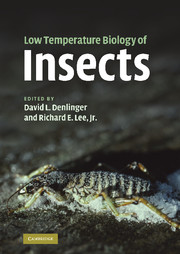Book contents
- Frontmatter
- Contents
- List of contributors
- Preface
- PART I PHYSIOLOGICAL AND MOLECULAR RESPONSES
- 1 A primer on insect cold-tolerance
- 2 Rapid cold-hardening: Ecological significance and underpinning mechanisms
- 3 Antifreeze and ice-nucleator proteins
- 4 Genomics, proteomics and metabolomics: Finding the other players in insect cold-tolerance
- 5 Cell structural modifications in insects at low temperatures
- 6 Oxygen: Stress and adaptation in cold-hardy insects
- 7 Interactions between cold, desiccation and environmental toxins
- PART II ECOLOGICAL AND EVOLUTIONARY RESPONSES
- PART III PRACTICAL APPLICATIONS
- Index
- References
1 - A primer on insect cold-tolerance
from PART I - PHYSIOLOGICAL AND MOLECULAR RESPONSES
Published online by Cambridge University Press: 04 May 2010
- Frontmatter
- Contents
- List of contributors
- Preface
- PART I PHYSIOLOGICAL AND MOLECULAR RESPONSES
- 1 A primer on insect cold-tolerance
- 2 Rapid cold-hardening: Ecological significance and underpinning mechanisms
- 3 Antifreeze and ice-nucleator proteins
- 4 Genomics, proteomics and metabolomics: Finding the other players in insect cold-tolerance
- 5 Cell structural modifications in insects at low temperatures
- 6 Oxygen: Stress and adaptation in cold-hardy insects
- 7 Interactions between cold, desiccation and environmental toxins
- PART II ECOLOGICAL AND EVOLUTIONARY RESPONSES
- PART III PRACTICAL APPLICATIONS
- Index
- References
Summary
Introduction
Low temperature affects insects differently based on the severity of the cold and the duration of exposure. Life stage and acclimation state also have a major impact on an insect's response to low temperature. Many temperate and polar insects enhance their cold-tolerance seasonally in preparation for winter, as short, cool days in autumn trigger cold acclimatization, as well as entry into the metabolic depression of diapause. However, insects also have the capacity to make significant and rapid adjustments to even slight changes in environmental temperature, as would occur on a summer's day.
This introductory chapter seeks to provide a short primer on the physiology of insect cold-tolerance that will be useful to students and others new to the area of study. This overview of basic concepts in insect cold-tolerance intends to provide a context for later chapters providing in-depth reviews of specific areas. Specifically, this primer focuses on regulation of supercooling and ice nucleation, and basic adaptations promoting cold-tolerance. Suggestions for conducting and clearly reporting experimental results on insect cold-tolerance are also included. Since this volume is intended to update and complement our previous book, Insects at Low Temperature (Lee and Denlinger, 1991), this synoptic chapter will emphasize articles published during the past 20 years and topics not covered elsewhere in this volume.
Types of insect cold-tolerance
Chilling and cold are relative terms; consequently, the temperature ranges they represent vary depending on the species in question.
- Type
- Chapter
- Information
- Low Temperature Biology of Insects , pp. 3 - 34Publisher: Cambridge University PressPrint publication year: 2010
References
- 156
- Cited by



